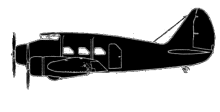
ASN Wikibase Occurrence # 27137
This information is added by users of ASN. Neither ASN nor the Flight Safety Foundation are responsible for the completeness or correctness of this information.
If you feel this information is incomplete or incorrect, you can submit corrected information.
| Date: | Wednesday 31 January 1945 |
| Time: | 08:20 approx |
| Type: |  Stinson Model A |
| Owner/operator: | Australian National Airways |
| Registration: | VH-UYY |
| MSN: | 9130 |
| Fatalities: | Fatalities: 10 / Occupants: 10 |
| Aircraft damage: | Destroyed |
| Category: | Accident |
| Location: | Spring Plains, VIC -
 Australia Australia
|
| Phase: | En route |
| Nature: | Passenger - Scheduled |
| Departure airport: | Melbourne-Essendon Airport, VIC (MEB/YMEN) |
| Kerang Airport, VIC (KRA/YKER) |
The Stinson Model A, named "Tokana", crashed following an in-flight break-up 2 miles east of Redesdale, Australia. Pilot Capt Alan Murn, co-pilot 1st Off Orville Openshaw and eight passengers died.
The aircraft was converted in 1943 to twin-engine configuration by removing the three Lycoming engines and installing a 550 hp 9-cylinder Pratt & Whitney R-1340-AN1 Wasp engine on each wing. The aircraft as subsequently used by Australian National Airways on the Melbourne-Kerang-Mildura-Broken Hill route.
Examinations determined that separation of the left wing was initiated by metal fatigue of the lower main spar boom attachment socket. The primary structure of the Stinson was of welded steel tube construction. A fatigue crack had initiated in weld metal on the inner surface of the socket. After propagating through the weld metal during a large number of flights, the fatigue crack entered the socket's parent metal. This crack eventually affected 45% of the cross-section of the socket before the lower boom failed on the fatal flight. Investigators noted the amount of metal in the socket that was unaffected by the fatigue crack at the time of the accident and calculated that the wing was capable of supporting loads up to about 2.5 times the weight of the aircraft on its fatal flight. This suggested the gusting winds prevailing at the time, and the turbulence associated with the low altitude at which the aircraft was flying, were partly responsible for the failure.
As a result of the accident, the Department of Civil Aviation began a practice of calculating the safe retirement life of metal aircraft registered in Australia.
The Structures and Materials Division of the Division of Aeronautics laboratory began a long-term program aimed at advancing the knowledge of metal fatigue in aircraft structures. Some 200 surplus wings of P-51 Mustang were tested by repeated loading to examine the characteristics of fatigue in aircraft structures.
Sources:
Air Crash Vol.2/Mcartur Job
https://trove.nla.gov.au/newspaper/article/1098133
Images:

Archerfield Airdrome, Brisbane, Qld, Australia. Date: August 5 1937.
Revision history:
| Date/time | Contributor | Updates |
|---|---|---|
| 27-Sep-2008 01:00 | ASN archive | Added |
| 22-Aug-2010 14:36 | TB | Updated [Time, Cn, Operator, Other fatalities, Location, Phase, Nature, Departure airport, Destination airport, Source, Narrative] |
| 23-Feb-2011 04:21 | harro | Updated [Departure airport] |
| 27-Jan-2018 13:06 | harro | Updated [Departure airport, Destination airport, Source, Narrative] |
| 27-Jan-2018 13:13 | harro | Updated [Narrative] |
| 29-Jan-2020 09:15 | TigerTimon | Updated [Time] |
| 23-Nov-2020 09:02 | Anon. | Updated [Photo] |
| 31-Oct-2023 07:42 | Ron Averes | Updated [[Photo]] |
Corrections or additions? ... Edit this accident description
The Aviation Safety Network is an exclusive service provided by:


 ©2024 Flight Safety Foundation
©2024 Flight Safety Foundation